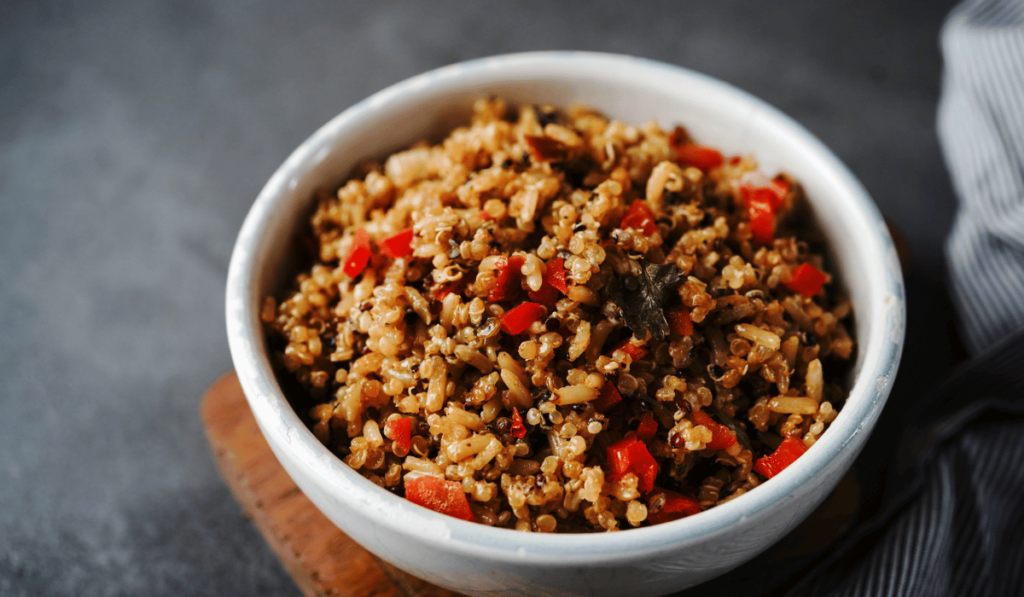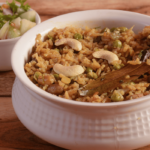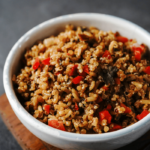The Best Fluffy Pancakes recipe you will fall in love with. Full of tips and tricks to help you make the best pancakes.
Table of Contents
ToggleHow to Cook Millet Rice
Millet rice is a nutritious and versatile grain that has gained popularity in recent years. Whether you’re looking for a gluten-free alternative to traditional rice or simply want to explore new culinary options, learning how to cook millet rice is a skill worth acquiring. In this comprehensive guide, we will take you through the step-by-step process of cooking millet rice to perfection. From selecting the right millet variety to preparing and serving it, we’ve got you covered.
1. Millet Rice
Millet rice, also known as millet grains or millet seeds, is a small, round grain that comes from various grass species. It has been consumed for thousands of years and is a staple in many cultures around the world. Millet rice is highly versatile and can be used in a variety of dishes, from salads to pilafs.
2. Health Benefits of Millet Rice
Millet rice is not only delicious but also packed with essential nutrients. It is a good source of fiber, protein, and various vitamins and minerals. Additionally, millet rice is gluten-free, making it an excellent option for individuals with gluten sensitivities or celiac disease. The fiber content in millet rice promotes digestion and helps maintain stable blood sugar levels.
3. Types of Millet Rice
There are several types of millet rice available, each with its own unique flavor and texture. Common varieties include:
Each variety has its own distinct characteristics and can be used in different recipes. Experimenting with different types of millet rice can add variety and excitement to your meals.
4. Choosing the Right Millet Variety
When selecting millet rice, consider the flavor profile and texture you desire. Pearl millet has a slightly nutty flavor and a chewy texture, while foxtail millet has a milder taste and a soft, fluffy texture. Finger millet has a rich, earthy flavor and a slightly crunchy texture. Proso millet, on the other hand, has a mild, slightly sweet flavor and a light, fluffy texture. Choose the variety that best suits your taste preferences and the desired dish.
5. Preparing Millet Rice
Before cooking millet rice, it is essential to prepare it properly to ensure optimal results. Here’s a step-by-step guide to help you get started:
Washing the Millet
Start by thoroughly rinsing millet rice under cold water. This step helps remove any impurities and excess starch from the grains.
Soaking Millet (Optional Step)
While soaking millet rice is not necessary, it can help improve its digestibility and reduce cooking time. Soaking the grains for 30 minutes to an hour can make them softer and easier to cook.
Cooking Millet Rice on the Stove
To cook millet rice on the stove, follow these simple steps:
- Use a saucepan with a tight-fitting lid. For every cup of millet rice, use two cups of water or broth.
- Bring the water or broth to a boil and add the rinsed millet rice.
- Reduce the heat to low, cover the saucepan with the lid, and let it simmer for 15-20 minutes or until the grains are tender and have absorbed the liquid.
- Remove the saucepan from the heat and let it sit, covered, for 5 minutes to allow the grains to steam.
Cooking Millet Rice in a Rice Cooker
If you prefer using a rice cooker, here’s how to cook millet rice:
- Rinse the millet rice under cold water and drain well.
- Add the rinsed millet rice and the appropriate amount of water or broth to the rice cooker.
- Close the rice cooker and select the “rice” or “grains” setting.
- Once the rice cooker switches to the “keep warm” mode, let the millet rice sit for an additional 5 minutes before fluffing it with a fork.
Fluffy and Fluffy Millet Rice
For fluffier millet rice, use a fork to fluff the grains gently after cooking. This step helps separate the grains and prevent them from clumping together.
6. Flavoring Millet Rice
Millet rice has a mild, nutty flavor that pairs well with a variety of seasonings and ingredients. Here are some ways to enhance the taste of your millet rice:
Adding Herbs and Spices
Infuse your millet rice with aromatic herbs and spices for a burst of flavor. Common options include garlic, onion, turmeric, cumin, coriander, and thyme. Saute the herbs and spices in a little oil before adding the millet rice to create a fragrant base.
Adding Vegetables
To make your millet rice more nutritious and vibrant, add chopped vegetables such as carrots, peas, bell peppers, or spinach. Sauté the vegetables before adding the millet rice, or simply stir them in during the cooking process.
Enhancing the Flavor with Broth
Instead of using plain water, cook your millet rice in vegetable or chicken broth for added depth of flavor. The broth will infuse the grains with savory notes and make your dish even more delicious.

7. Serving Suggestions
Millet rice can be enjoyed in various ways, depending on your preference and the dish you’re preparing. Here are some serving suggestions to inspire you:
Millet Rice as a Side Dish
Serve millet rice as a nutritious and wholesome side dish alongside grilled vegetables, roasted chicken, or stir-fried tofu. Its mild flavor complements a wide range of main courses.
Millet Rice as a Base for Bowls
Create nourishing grain bowls by using millet rice as a base. Top it with your favorite proteins, such as grilled salmon or tofu, and an assortment of colorful vegetables. Drizzle with a flavorful dressing for a complete and satisfying meal.
Millet Rice in Soups and Stews
Add cooked millet rice to hearty soups and stews for added texture and nutrition. It can serve as a delightful alternative to other grains, such as barley or rice, and add a unique twist to traditional recipes.
8. Millet Rice Recipes
If you’re looking for inspiration, here are three delicious millet rice recipes to try:
Millet Rice Pilaf
Ingredients:
- 1 cup millet rice
- 2 cups vegetable or chicken broth
- 1 small onion, diced
- 2 cloves garlic, minced
- 1 carrot, diced
- 1/2 cup peas
- 1 tablespoon olive oil
- Salt and pepper to taste
Instructions:
- Heat olive oil in a saucepan over medium heat. Add the onion and garlic, and sauté until fragrant.
- Add the millet rice to the saucepan and stir for a minute to coat the grains with oil.
- Pour in the vegetable or chicken broth and bring to a boil. Reduce the heat to low, cover the saucepan, and simmer for 15-20 minutes or until the millet rice is cooked and the liquid is absorbed.
- In a separate pan, sauté the carrot and peas until tender. Season with salt and pepper.
- Once the millet rice is cooked, fluff it with a fork and stir in the sautéed vegetables.
- Serve hot as a side dish or as a light main course.
ALSO READ: How to Cook Seeraga Samba Rice in a Pressure Cooker Step-by-Step Guide.
Millet Rice Salad
Ingredients:
- 1 cup cooked millet rice
- 1 cucumber, diced
- 1 tomato, diced
- 1/4 cup red onion, finely chopped
- 1/4 cup fresh parsley, chopped
- Juice of 1 lemon
- 2 tablespoons olive oil
- Salt and pepper to taste
Instructions:
- In a large bowl, combine the cooked millet rice, cucumber, tomato, red onion, and parsley.
- In a separate small bowl, whisk together the lemon juice, olive oil, salt, and pepper.
- Pour the dressing over the millet rice mixture and toss gently to coat.
- Let the salad sit for a few minutes to allow the flavors to meld.
- Serve chilled as a refreshing side dish or as a light lunch.
Millet Rice Porridge
Ingredients:
- 1/2 cup millet rice
- 3 cups water or milk
- 2 tablespoons honey or maple syrup
- 1/2 teaspoon vanilla extract
- 1/4 teaspoon ground cinnamon
- Toppings of your choice (e.g., fresh berries, sliced banana, chopped nuts)
Instructions:
- Rinse the millet rice under cold water and drain well.
- In a medium saucepan, combine the millet rice and water or milk. Bring to a boil over medium heat.
- Reduce the heat to low and simmer, stirring occasionally, for 20-25 minutes or until the millet rice is tender and the mixture has thickened.
- Stir in the honey or maple syrup, vanilla extract, and ground cinnamon.
- Remove from heat and let it cool slightly before serving.
- Top with your favorite toppings, such as fresh berries, sliced banana, and chopped nuts.
9. Tips and Tricks for Cooking Millet Rice
To ensure a successful millet rice cooking experience, here are some helpful tips and tricks:
Proper Water-to-Millet Ratio
For fluffy and tender millet rice, use a 1:2 ratio of millet rice to water or broth. This ratio provides the right amount of moisture for the grains to cook evenly and absorb the liquid adequately.
Adjusting Cooking Time
The cooking time may vary depending on the variety of millet rice and personal preference. If you prefer softer and more well-cooked grains, increase the cooking time by a few minutes. Conversely, if you prefer slightly chewier grains, reduce the cooking time accordingly.
Toasting Millet for Extra Flavor
For an extra layer of flavor, consider toasting the millet rice before cooking it. Simply heat a dry skillet over medium heat, add the millet rice, and toast it for a few minutes until it becomes fragrant and golden brown. This step enhances the nuttiness of the millet rice and adds depth to your dishes.
10. Frequently Asked Questions (FAQs)
Can you freeze cooked millet rice?
Yes, you can freeze cooked millet rice. Allow it to cool completely, then transfer it to airtight containers or freezer bags. Label and date the containers before placing them in the freezer. Cooked millet rice can be stored in the freezer for up to three months.
How long does cooked millet rice last in the refrigerator?
Cooked millet rice can be stored in the refrigerator for up to five days. Make sure to place it in an airtight container to maintain its freshness.
Can you use millet rice in sushi?
While millet rice can be used as a substitute for traditional sushi rice, it has a slightly different texture. If you enjoy experimenting with flavors and textures, give it a try! Keep in mind that millet rice may require additional seasoning to mimic the flavors of sushi rice.
11. Conclusion
Cooking millet rice is a rewarding culinary adventure that opens up a world of possibilities. Its versatility, nutritional benefits, and delicious taste make it a valuable addition to any kitchen. By following the step-by-step guide and incorporating the suggested recipes and tips, you’ll be able to master the art of cooking millet rice with ease. So go ahead, give it a try, and enjoy the delightful flavors and textures that millet rice has to offer.




